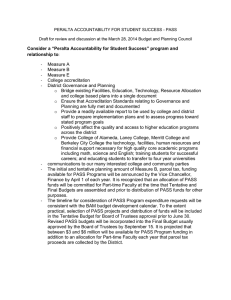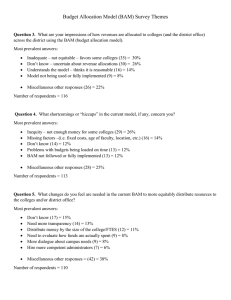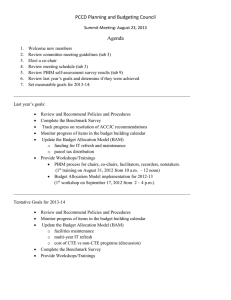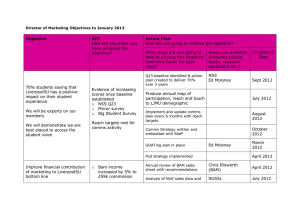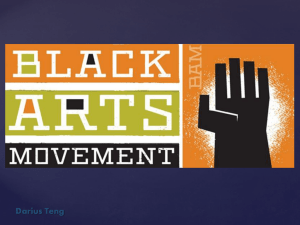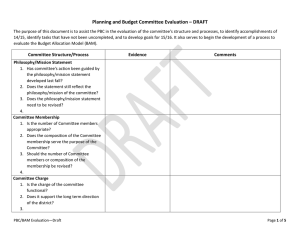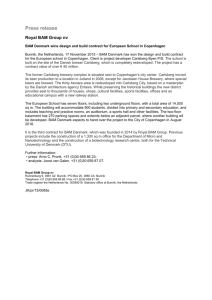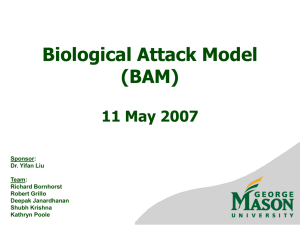Project Status Update #1
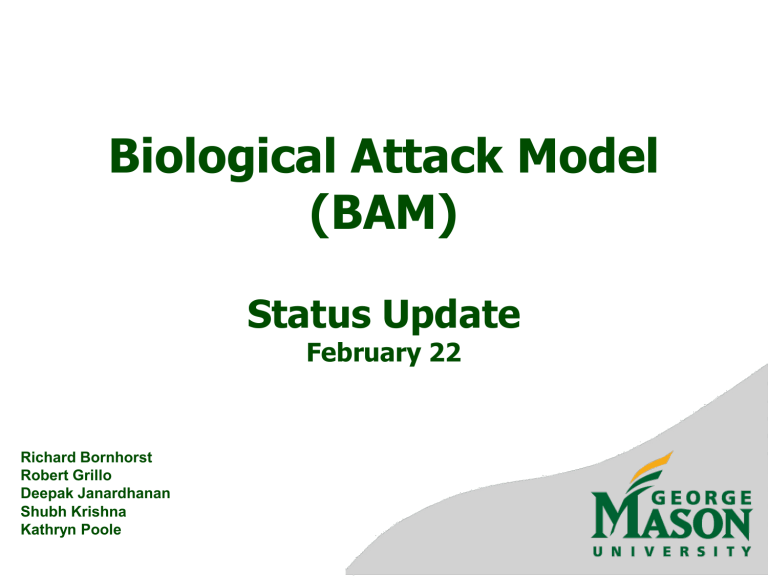
Biological Attack Model
(BAM)
Status Update
February 22
Richard Bornhorst
Robert Grillo
Deepak Janardhanan
Shubh Krishna
Kathryn Poole
2
Agenda
•
Project Concept
•
Project Plan
•
Project Risk Assessment
•
Biological Agent Overview
•
BAM Schematic
•
Model Overview
3
Project Concept
• Develop a Biological Attack Model (BAM) to assist the Emergency Management Agency (EMA) and emergency responders with crisis management in the event of a biological attack
– Minimize the exposure of biological agents to responders and the general public
• Target aspects of the biological attack model that will benefit stakeholders the most
• Provide models, plans, or procedures to address identified gaps in the current model of a biological attack
Project Plan
Description
Research Biological Agents
Research Existing Models
Detailed Design and Model
Development
Progress Presentation
Status Report # 2
Progress Discussion
Testing, Evaluation, and
Recommendations
Formal Progress Presentation
Final Report Drafting
Final Report Due
Presentation Preparation
Final Presentation
WEEK 5 WEEK 6 WEEK 7 WEEK 8 WEEK 9 WEEK
10
WEEK
11
WEEK
12
WEEK
13
WEEK
14
WEEK
15
Slip
4
5
Project Risk Assessment
• A biological attack is a very complex event
• A project risk assessment was conducted to determine which tasks are feasible within the time constraints of one semester
– Original Project would require 1240 man-hours to complete
– Team members can contribute 10 man-hours per week
– 1240 > 750 (10 times 15 weeks)
• Adjusted project plan reduces the man-hours required to roughly 775 man-hours
– Eliminated dispersion modeling (use existing models)
– Reduced disease behavior modeling (mod an existing model)
– Primarily focus on containment modeling
6
Biological Agent Overview
• 22 biological agents that could be considered potential bioterror weapons were initially considered for BAM
– Based on lists from agencies such as the CDC and WHO
• Bio-terror agents can be classified by transmission method
– Person to person
– Airborne
– Foodborne
• The bulk of development for BAM will be in building and refining the disease spread and containment models
– BAM was scaled back to focus exclusively on one transmission type
• Selected person to person transmission
• New, reduced, list of pathogens considered for BAM:
– Smallpox
– Ebola
– Viral Encephalitis
Biological Agent Overview
7
• All three agents spread through human body fluids and can potentially be made into an aerosol weapon
– Smallpox
• Sores, blisters, and boils appear, killing skin cells and spreading to internal organs
• Also spread through blankets and clothing contact
• Can be vaccinated after exposure, but before symptoms appear
(no other treatment available)
– Ebola
• Skin rash, damage to liver, kidneys, and other organs leading to bleeding from all openings
• No current vaccine or treatment
– Viral Encephalitis
• Causes abnormal behavior, paralysis, convulsions, and death from nerve/brain damage
• Also spread through animal fluids
• No vaccine for most forms, but with proper care, many people can recover
8
BAM Schematic
Disease Data
Small Pox
Ebola
Viral E.
Spread Model
Decision
SIR
Link
Disease Spread Model
Markov
Chain
Model
Link
Custom
Spread
Model
Situation Analysis
&
Reporting
Census Data
Scenario Related
Data Decisions
Initial Conditions
&
Intermediate
Conditions
Epidemic Model Overview
9
• BAM will be built upon the SIR model (Susceptible –
Infected – Recovered)
– SIR is widely used to model the spread of epidemics and to study immunization strategies within a population
– The standard SIR model is not adequate for BAM
SIR Model
Populations Tracked
S t
I t
R t
= the number of susceptible individuals at time t
= the number of infected individuals at time t
= the number of recovered individuals at time t
Input Variables
B = transmission rate
K = recovery rate
Epidemic Model Overview
10
• Biological Attack Model (BAM) will expand upon the basic SIR model to incorporate additional parameters relevant to response planning
– Quarantine
• Percentage of infected population quarantined per day
• Percentage of contacts of infected population quarantined per day
– Treatment (vaccination, antibiotics, etc.)
• Percentage of infected population treated per day
• Percentage of susceptible population treated per day
– Deaths related to the bio-attack
• Mortality rate of the disease
• Mortality rate of treatment (vaccination, antibiotics, etc.)
• Once complete, BAM will be used to perform parametric studies and sensitivity analyses that will be detailed in the final briefing and report
11
